JAPANESE NUCLEAR SAFETY SCANDALS
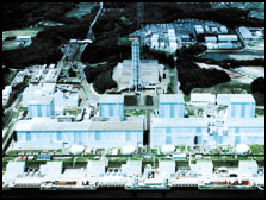
Fukushima Daini nuclear plant Evan Osnos wrote in The New Yorker: Nuclear-safety scandals began to emerge. In June, 2002, Tokyo Electric was forced to reveal that for two decades it had faked hundreds of repair records, at the Fukushima Daiichi plant and at several other reactors. Five years later, it conceded that it had lied in its previous acknowledgment of lying and owned up to six more emergencies at Fukushima Daiichi that had been concealed. The gravest error, perhaps, was underestimating the risk of tsunamis. The Nuclear Safety Commission’s official guidelines declared that, in the event of a big wave, “safety functions of facilities shall not be significantly affected.” But experts inside and outside the government had warned authorities about new research on the speed of meltdowns in the event of a power loss and the acute threat posed by storing diesel generators in a basement. [Source: Evan Osnos, The New Yorker, October 17, 2011]
Of all the warnings that were ignored, the most significant was from the past. On June 24, 2009, two senior Japanese seismologists appeared before a government-led safety panel to warn that the Fukushima Daiichi plant was acutely vulnerable to tsunamis. They pointed to the words of ancient historians who described a wave in the year 869 so large that it left “no time to get into boats or climb the mountains”; it devastated a castle and left “everything utterly destroyed.” According to a transcript of the hearing, a Tokyo Electric official responded that “future research should evaluate” the claim, because it appeared that “there isn’t much evidence of damage.” The plant was designed to absorb swells of up to about nineteen feet in height; the tsunami that arrived in March was more than twice that tall.
Nuclear Power Plants and Earthquakes in Japan
Of the 31 nations and regions with nuclear power plants, Japan is the most at risk of being hit by an earthquake. Particularly worrisome is the fact that Japan has lots of nuclear power plants and nuclear power plants and nuclear treatment facilities are built in earthquake-prone areas. The nuclear industry claims these facilities are safe. They are designed to withstand a strong earthquake and the maximum ground motion caused by such a quake. Safety measures include devices that automatically shut the plant after an earthquake occurs and prevent leakage, incredibly strong foundations and containment shells.
Japan’s plants are all located in coastal areas, making them vulnerable to both quakes and tsunamis. Katsuhiko Ishibashi, a seismologist and now professor emeritus at Kobe University, told the New York Times “The Japanese archipelago is a place where you shouldn’t build nuclear plants.” In the early days of nuclear power generation in Japan, the government and nuclear plant operators assured the public of the safety of plants by promising that they would not be located on top of active fault lines, Ishibashi said. But he said that advances in seismology have led to the gradual discovery of active fault lines under or near plants, creating an inherent problem for the operators and the government and leading to an inevitable conclusion for critics of nuclear power.
Some nuclear power plants are being shut down permanently because the cost retrofitting them to make them to meet the latest earthquake resistance standards is too expensive.
In March 2006, a court ordered that the Shika nuclear reactor, located on the Japan Sea north of Kanazawa, be closed over worries that it wasn’t earthquake-resistant enough and there was serious concerns that residents could be exposed to dangerous amounts of radiation in the event of an accident. A major fault is located about 10 kilometers south of the plant. A couple years earlier scientists estimated there was a 2 percent chance that an earthquake of a magnitude of 7.6 or higher could occur on this fault.
The decision raised questions about other reactors that lie in earthquake-prone areas and whether their designs could withstand a very strong quake. Plants in Miyagi Prefecture survived and automatically stopped during a 7.2 earthquake in the August 2005. Scientists predict a 7.5 earthquake will occur there in the next 30 years. Active faults under Tohoku Electric's Higashidori nuclear power complex in Aomori Prefecture are grounds for a reassessment of the plant's seismic safety.
See Iwate-Miyagi Earthquake, Nature and Science, Big Earthquakes
A 15-kilometer-long active fault lies under the Monju fast breeder reactor in. Tsuruga Peninsula in Fukui Prefecture. The revelation is disturbing in that the plant uses dangerous plutonium as one of the reactors primary fuels.
Nuclear Power and the Niigata Earthquake in 2007

Kashiwazaki Kaiwa nuclear plant At 5:56pm on October 23, 2004, an earthquake measuring 6.8 on the Richter scale hit the Chuetsu region of Niigata prefecture, killing 67 people and injuring 4,805 and damaging the Kashiwazakai-Kariwa nuclear power plant,
At the time of the earthquake three reactors at Kashiwazakai-Kariwa nuclear power plant in Niigata were operating at full power and one was in start up mode. These four nuclear reactors — Nos. 2, 3, 4 and 7 — shut down automatically because of the earthquake; heat was removed from the cores; and radioactive materials were confined. The force of the quake was so strong that roads within the power plant grounds buckled to such a degree that cars could not pass. The other three reactors were not operating because they were undergoing scheduled inspections at the time of the quake.
The safety system , including the “shutdown,” “cooling and “containment” operations, performed according to plan. At the time of the quake the control rods were fully inserted . After the initial shutdown attention was devoted to cooling the reactor water from 286 degrees C to less than 100 degrees C, something that took 21 hours to achieve.
Kashiwazakai-Kariwa nuclear power plant is the world’s largest nuclear power plant. It covers 42.2 square kilometers and has a capacity of 8,212 MW and supplies nearly 20 percent of the electricity for the greater Tokyo area.
The fault that caused the earthquake goes directly under the nuclear power plant and had not been detected until the earthquake occurred, The inability of TEPCO to find the fault and predict that high intensity earthquakes would occur there worried many. TEPCO admitted it didn’t find the fault but said there was no serious danger because the fault was too deep — 12 miles under the surface — to cause the kinds of crack that could damage the thick concrete buildings that surround the reactors.
Problems with Nuclear Power and the Niigata Earthquake in 2007
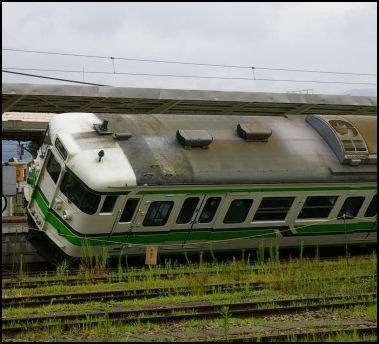
Damage from 2007 Niigata earthquake A small fire broke out in an electricity transformer of the No. 3 reactor, sending black smoke billowing into the air, but no damage was reported to the reactor. A small amount of coolant containing radioactive material leaked from the No. 6 reactor. Images of a fuel-storage pool in reactor No. 3 show meter-high waves generated by the quake sloshing outside the pool.
The plant was designed t withstand short, intense tremors not the broad, horizontal swaying that occurred with the 2007 earthquake This caused water to slosh out of storage pools, with around 1,200 liters contaminated with small amount of radioactive material reaching the Sea of Japan.
At least 63 other problems were reported, including burst pipes, water leaks, and radioactive waste spillage. In five of the reactors major exhaust pipes were knocked out of place. About 100 drums containing radioactive water fell over. Some of them were found with their lids open, Small amounts of cobalt-60 and chromium-51 leaked into the atmosphere.
All these problems were an embarrassment for a nation that touted its nuclear reactors as being earthquake proof. Three days after the earthquake the Niigata government ordered Tokyo Electric Power Company (TEPCO), the owner and builder of the plant, to shut the plant down. The earthquake also raised concerns about Japan’s 48 other nuclear reactors, many which are situated in earthquake-prone areas. Lawsuits were filed seeking the closure of at least four plants because they are located near faults. They include one in Shija in western Japan, where are large vault was found in 2005.
The shut down of the plant caused strains on Japan’s electricity-generating system and caused power shortages. Electricity generated by nuclear power decline from 69 percent to 63 percent with the loss of Kashiwaszaki-Kariwa nuclear power plant. TEPCO took emergency measures for the first time in 17 years to meet electricity demand during the height of the heat wave in August 2007 because the Kashiwazakai-Kariwa nuclear power plant was still down.
The Kashiwazaki-Kariwa went online in May 2009 for the first time since the earthquake and went into service two months later. Electricity generated by nuclear power in Japan decline from 69 percent to 63 percent with the loss of Kashiwaszaki-Kariwa nuclear power plant because of the earthquake in Niigata.
Nuclear Power Companies Subject to Cyber Attacks
In November 2011 NHK reported: The operators of nuclear power plants in Japan have become the latest victims of cyber criminals. NHK asked 10 electric power companies that manage nuclear power plants if they have experienced attacks on their computer networks in the past year.Tokyo Electric Power Company, Hokkaido Electric Power Company and Tohoku Electric Power Company said they had received targeted cyber attacks through emails disguised as business communications from government offices. [Source: NHK, November 7, 2011]
TEPCO says, however, that it has no evidence of an information leak. Five other utilities reported that their computers were hit by viruses delivered through email, but they also said they have had no data leakage. Noting past cyber attacks on nuclear facilities abroad, Keio University Professor Keiji Takeda says hackers may have sent viruses to try and collect data from plants in Japan. He says not only electric power companies, but also gas and water suppliers, railway operators and other infrastructure operators should share information on viruses and check again to see if their computers have been infected. Earlier, Japanese government institutions and defense contractors came under cyber attacks.
Extending the Life of Japanese Nuclear Plants
Japanese nuclear reactors have had their lifespan extended to as much as 46 years. In June 2010, the government’s nuclear regulatory agency gave permission for a 40-year-old reactor, the No. 1 Tsuruga in Fukui Prefecture, to operate for an addition six years. Most plants are supposed to stop operating after 30 years.
Japan’s oldest nuclear reactor, in Tsuruga in Fukui Prefecture , reached the age of 40 in 2010 and was given a green light to operate through 2016.
In January 2012 the Yomiuri Shimbun reported: The government has decided it will allow the nation's nuclear power reactors to continue operations for a maximum of 60 years by extending the legally permitted period by 20 years as an exceptional measure. The government initially planned to set the operation limit of nuclear reactors to a maximum 40 years in principle, by revising the Nuclear Reactor Regulation Law. However, the government said a bill to revise the law will include a provision to allow power companies to extend the period only once by 20 years. [Source: Yomiuri Shimbun, January 19, 2012]
At a press conference Goshi Hosono, state minister for nuclear power policy and administration, first announced the revision plan, saying: "An extension is an absolutely exceptional case. The government's basic stance is that nuclear reactors should be decommissioned after the 40-year limit." Hosono, also the environment minister, emphasized at that time that exceptions are no more than exceptions. However, a senior Environment Ministry official said, "If an exceptional provision is included in the law, there will be a strong tendency to proactively utilize it."
According to the Cabinet Secretariat's Office for the Preparation of Nuclear Safety Regulatory Organization Reform, the exception clause is modeled after a U.S. system, which limits a reactor's operation period to 40 years, but allows extensions of up to 20 years. "Considering worldwide trends, the stipulation to allow an extension period of 20 years is appropriate," an official of the office explained.
Concealed Evidence About Japanese Nuclear Power Plants
Other lawsuits reveal how operators have concealed evidence of active fault lines. In the case of Kashiwazaki-Kariwa nuclear plant in Niigata, a prefecture facing the Sea of Japan, Tokyo Electric Power Company, or Tepco, the utility that also operates Fukushima Daiichi, did not disclose the existence of an active fault line until an earthquake forced it to. [Source: Norimitsu Onishi and Martin Fackler, New York Times, May 16, 2011]
In 1979, residents sued the government to try overturn its decision granting Tepco a license to build a plant there. They argued that nuclear regulators had not performed proper inspections of the area’s geology — an accusation that the government would acknowledge years later — and that an active fault line nearby made the plant dangerous. In 2005, the Tokyo High Court ruled against the plaintiffs, concluding that no such fault line existed.
But in 2007, after a 6.8-magnitude earthquake damaged the plant, causing a fire and radiation leaks, Tepco admitted that, in 2003, it had determined the existence of a 12-mile-long active fault line in the sea nearby.
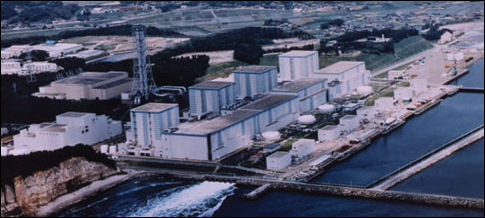
Fukushima plant
Underestimating Dangers of Japanese Nuclear Power Plants
Some lawsuits reveal how operators have dealt with the discovery of active fault lines by underestimating their importance as nuclear regulators remained passive. For 12 years, Yasue Ashihara has led a group of local residents in a long and lonely court battle to halt operations of the Shimane nuclear plant, which sits less than five miles from Matsue, a city of 200,000 people in western Japan. Ms. Ashihara’s fight against the plant’s operator, Chugoku Electric Power, revolves around not only the discovery of a previously unknown active fault line, but an odd tug of war between her group and the company about the fault’s length, and thus the strength of the earthquakes it is capable of producing. [Source: Norimitsu Onishi and Martin Fackler, New York Times, May 16, 2011]
The utility has slowly accepted the contention of Ms. Ashihara’s group by repeatedly increasing its estimate of the size of the fault. Yet a district court last year ruled in favor of Chugoku Electric Power, accepting its argument that its estimates were based on the better scientific analysis. “We jokingly refer to it as the ever-growing fault line,” said Ms. Ashihara, 58, who works as a caregiver for the elderly. “But what it really means is that Chugoku Electric does not know how strong an earthquake could strike here.”
Her group filed the lawsuit in 1999, a year after the operator suddenly announced that it had detected a five-mile-long fault near the plant, reversing decades of claims that the plant’s vicinity was free of active faults. Chugoku Electric said the fault was too small to produce an earthquake strong enough to threaten the plant, but Ms. Ashihara’s suit cited new research showing the fault line could in fact be much longer, and produce a much stronger earthquake. It got a boost in 2006, when a seismologist announced that a test trench that he had dug showed the fault line to be at least 12 miles long, capable of causing an earthquake of magnitude 7.1.
After initially resisting, the company reversed its position three years ago to accept the finding. But a spokesman for the Chugoku Electric said the plant was strong enough to withstand an earthquake of this size without retrofitting. “This plant sits on solid bedrock,” said Hiroyuki Fukada, assistant director of the visitor center for the Shimane plant, adding that it had a 20-foot, ferro-concrete foundation. “It is safe enough for at least a 7.1 earthquake.” However, researchers now say the fault line may extend undersea at least 18 miles, long enough to produce a magnitude 7.4 earthquake. This prompted Ms. Ashihara’s group to appeal last year’s ruling.
Ms. Ashihara said she has waged her long fight because she believes the company is understating the danger to her city. But she says she has at times felt ostracized from this tightly bound community, with relatives frowning upon her drawing attention to herself. Still, she said she hoped the shutdown of Hamaoka would help boost her case. She said local residents had already been growing skeptical of the Shimane plant’s safety after revelations last year that the operator falsified inspection records, forcing it to shut down one of the plant’s three reactors.
Nuclear Accidents in Japan
In February 1991, a rupture of a coolant tube in reactor at the Mihama nuclear power plant caused the released of 55 tons of radioactive water. The accident caused activating the emergency cooling system for the first time in Japan. The Mihama plant is located near some popular beach resorts of Kyoto on the Japan Sea.
In November 1995, a radiation leaked from a fast-breeder nuclear plant at Tokaimura but the public wasn't informed about it until much later. In December 1996, there was a leak of coolant at $6 billion fast-breeder nuclear facility in Tsuruga, There was concern not only about the massive leak of liquid sodium but also about a failure to shut down facility immediately.
In March 1997, 37 worker at Tokaimura were exposed to radiation after a fire. In April 1997, 11 workers were exposed to low-level radiation at the Fugan reactor after exposure to tritium. In July 1999, 51 tons of primary coolant water leaked from the Tsuruga power station caused by a design flaw.
Shikamacho Nuclear Accident

nuclear fuel rods In June 1999, criticality — an uncontrollable nuclear chain reaction — endured for 15 minutes at the nuclear power plant in Shikamacho, Ishikawa Prefecture. During a regular check up, three of the 89 control rods in the reactor core slipped, causing the reactor to reactivate. The reactor was not automatically shut down for the 15 minutes it took workers to finish reinserting the three control rods by adjusting the valves of tanks of nitrogen used to put the rods in place.
Although the power generation was less than 1 percent of what the reactor is capable of producing the reactor was effectively uncontrollable for the entire time. Making matters worse was the fact that three covers of the reactor pressure vessel and containment vessel were removed for maintenance, lowering the ability to contain radiation. The accident was not reported until 2007.
The accident was the result of an error in the operation of water pressure adjustment valves used to control the rods, which are designed do absorbs neutrons and effectively control the nuclear chain reaction, and way the workers follow testing procedures. A similar incident involving five slipped roads occurred at a nuclear power plant in Fukushima in 1978.
Tokaimura Nuclear Accident
In September 1999, three workers were exposed to extremely high levels of radiation at a uranium conversion plant in Tokaimura (70 miles from Tokyo) and 150 others were exposed to dangerous levels of radiation. One of the workers died in December, 1999. Another worker died in April 2000. It was the worst nuclear accident in Japan's history at that time.
The accident occurred when workers a the plant accidently poured too much of a uranium-235 solution — 35.2 pounds instead of the required 5.2 pounds — into stainless steel buckets with nitric acid in them. The workers were mixing the radioactive materials by hand to save time and money. The first sign that something had gone wrong was a flash of blue light that caused one worker to fall unconscious and another to become nauseous and experience burns.
The workers were making a fuel for a breeder-type reactor, which is supposed to be done slowly and carefully. Instead the uranium was dumped in all at once and went critical (a sustained chain reaction) for 18 hours before it was contained, releasing large amounts of radiation, some of which threatened 300,000 people in the Tokaimura area.
Fallout of the Tokaimura Nuclear Accident
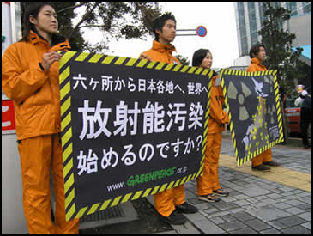
Greenpeace anti-nuclear protesters The handling of the incident showed how unprepared Japan was for a nuclear accident. Firefighters entered the radioactive zone without anti-radiation clothing because they hadn't been informed a nuclear accident had taken place. People in the area were advised to stay indoors and then told nothing for 12 hours, highways and train lines were closed as leaders went of television and admitted they weren't sure what was going on.
Initial efforts to put out the chain reaction failed because workers for the company couldn't get close enough to pour 880 pounds of sodium borate on the uranium. Finally after 17 hours the reaction was stopped after water was drained from a cooling jacket around the basin in which the uranium had been dumped. After that employees broke a pipe to speed water removal. Four hours after that acid was added to suppress the reaction.
Around the time of Tokaimura accident there was a string of safety problems and attempted cover ups were revealed. As a result the number of nuclear safety inspectors was doubled and they were given more authority. At one point Tokyo Power was forced to shut down all 17 of its nuclear plants after the company admitted to falsifying safety records.
Mihama Nuclear Power Plant Accident
Japan experienced its worst nuclear accident in August 2004, when four people were killed and seven others were injured when non-radioactive steam leaked from the reactor No. 3 at the Mihama Nuclear Power Plant (40 miles north of Kyoto). The deaths were the first at a nuclear plant. They were caused when superheated steam blew out of a crack in pipe. The plant was immediately shut down. No radiation was leaked.
The accident at the 836,000-kilowatt Mihama pressurized water reactor, which had been operation since 1976, was blamed old equipment and inadequate inspections. The pipe that blew out had not been inspected since 1976 and had corroded away nearly half an inch so that all the was left was metal not much thicker than aluminum foil.
KEPCO had been warned in the previous year that repair work was needed and the plant was scheduled to be shut down in a few days for a thorough inspection. The high pressure steam carried in the pipe was 300̊F. The blow out caused a two foot wide hole in the pipe. The workers that died were scalded to death. Five of the injured men were seriously burned.
American Diplomats Concerned Over Security at Japan’s Nuclear Sites
Martin Fackler wrote in the New York Times, “American officials repeatedly raised concerns about the security of Japanese nuclear plants from terrorist attacks but in at least one case were rebuffed by local officials, according to classified State Department cables made available by WikiLeaks. The cables from the United States Embassy in Tokyo were sent in 2006 and 2007, and recount warnings from American diplomats who visited Japanese nuclear plants and observed security drills. The Americans were raising concerns about Japan’s readiness for guerrilla-style attacks by groups like civilian terrorists or North Korean commandos. [Source: Martin Fackler, New York Times May 8, 2011]
In a cable dated Feb. 26, 2007, American officials expressed concern about the absence of armed guards at a nuclear facility in Tokaimura, north of Tokyo, which they described as “a major plutonium storage site.” But the Ministry of Science and Education, which oversees Japan’s nuclear sites, said “there was not a sufficient threat to justify armed police,” the cable said. The Japanese explained that the site was protected by civilian guards, who cannot be armed under Japanese law, the cable said.
Other cables described the placement of fences, security cameras and motion detectors, and the readiness of Japan’s coast guard to protect nuclear plants near the ocean from seaborne attacks. In the 2007 cable, the Americans also asked the ministry to conduct background checks of workers with access to sensitive areas of the Tokaimura site, as is standard practice in the United States. Ministry officials replied that while such checks were conducted “unofficially,” constitutional restrictions and privacy concerns prevented the government from making them routine.
While the cables noted that Japan was becoming more aware of threats to its nuclear facilities, they also faulted some countermeasures, particularly antiterrorism training drills, characterized as unrealistic. A cable dated Jan. 27, 2006, describes an antiterrorism drill at the Mihama nuclear plant in central Japan as “a bit too scripted and perfect.” A cable dated Nov. 2 of the same year faults a drill at the Tokaimura facility at which participants had been given “advance copies of the scenario.”
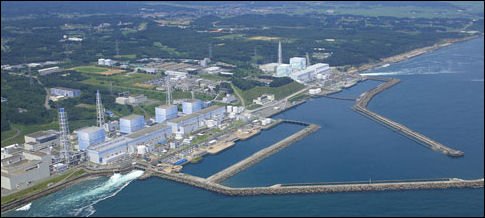
Fukushima plant before disaster
Image Sources: Japan Nuclear Power Program, TEPCO, Greenpeace Japan
Text Sources: New York Times, Washington Post, Los Angeles Times, Daily Yomiuri, Times of London, Japan National Tourist Organization (JNTO), National Geographic, The New Yorker, Time, Newsweek, Reuters, AP, Lonely Planet Guides, Compton’s Encyclopedia and various books and other publications.
Last updated April 2012
